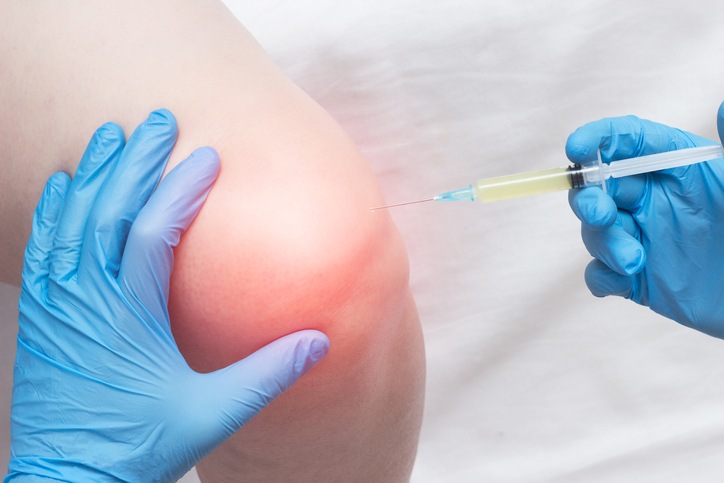PRP THERAPY
Indications
Platelet-rich plasma therapy is a form of regnerative medicine that can harness those abilities and amplify the natural growth factors your body uses to heal tissue. Platelet-Rich Plasma Therapy (PRP) is a process by which a patient's own blood is concentrated and then used to speed the healing of chronic tissue injuries, including tendinitis, sprains, and some milder forms of arthritis.
Any injury involving a partial tear to a tendon or ligament may benefit from a platelet-rich infusion. Complete tears and ruptures must be treated with surgery, although PRP therapy could in theory help speed the healing process after a restorative surgical procedure.
The most common usages of PRP therapy occur in injuries to the shoulder, knee, and elbow, including arthritic knee joints, rotator cuff tears, severe hamstring pulls, quadriceps injuries, and damage to the Achilles tendon behind the ankle.

Procedure
HOW DOES PRP THERAPY WORK?
Platelets contain proteins, called growth factors, which allow them to perform these actions. Without them, the body cannot signal itself to run in “healing mode,” which means that without platelets, your body would be unable control inflammation, heal tissues, or build new skin. In addition, platelets increase the production of collagen and stimulate blood flow, essential components in the body’s healing process.
PRP therapy aims to magnify the power of the platelet. By collecting and concentrating platelets into a single injection, an injured body part may benefit from up to five times as many growth factors than is contained in normal whole blood. Best of all, the blood comes from your own supply—eliminating any risks or mismatch, infection, contamination, or other problems that might lead to rejection.
PRP therapy is a relatively simple process that can be performed in under two hours. It does not require hospitalization, and may be done as an outpatient procedure
If you use corticosteroids or NSAID anti-inflammatory medicines, such as ibuprofen or naproxen , you will be required to have stopped taking them up to a week before PRP therapy, and not to resume use of these types of medications immediately afterwards. They will interfere with PRP therapy and possibly nullify any results.
Step 1: Collect the patient’s own blood.
Less than two ounces (between 15 to 50 milliliters) are required for the procedure. The collection is virtually identical to prp therapy process giving blood for a blood test, with a collection needle inserted into a vein in the arm and the blood captured in a small vial.
Step 2: Centrifuge the blood.
A centrifuge is a device that spins at high speeds. This action physically separates the solid and liquid parts of the blood: red blood cells (erythrocytes), white blood cells (leukocytes), platelets and plasma.
Step 3: Process and collect the platelets.
Regular blood contains about 200,000 platelets per milliliter, while platelet-rich plasma contains as much as five times that amount. The resulting three to seven milliliters of platelet-rich plasma will be collected in a syringe, to be administered immediately.
Step 4: Inject the PRP into the desired site.
The final syringe of platelet-rich plasma will contain approximately 6010 ml of fluid. With the guidance of an ultrasound probe, the PRP will be guided into the proper location, based on the nature of the injury being treated.The actual procedure of injecting platelet-rich plasma into an injury site first requires basic cleansing with alcohol, iodine, or betadine to ensure the skin is free of potential infection-causing microorganisms.As the procedure may take several minutes to complete, a local anesthetic will be used to ensure the patient is as comfortable as possible. To ensure the PRP is injected into the precise location required, ultrasound will be utilized to visualize the inside of the body, and to guide the doctor’s hand. A small amount of ultrasound gel will be applied to the skin over the affected site, and then a small ultrasound probe, or wand, will be pressed to the area. The resulting image will be transmitted directly to a screen. The plasma-rich platelets will now be injected into the joint capsule or other location. Once complete, the needle puncture will only require simple blotting and bandaging.
Special Instructions
Side Effects And Complications
Patients who undergo PRP therapy should be able to return to normal everyday activities almost immediately. As the injection of PRP fills the injury site with fluid, it is normal to perceive the area as swollen and tender, just as if you had suffered a sprain and its resultant swelling. Most patients may treat this discomfort with over-the-counter pain relievers, such as acetominaphin.
Remember, you should not treat any pain after your PRP therapy with NSAIDs (non-steroidal anti-inflammatory drugs) like naproxen and ibuprofen, as they will greatly interfere with the therapy.
A few patients may experience significant post-procedural pain, possibly due to the enhanced inflammatory action that PRP therapy promotes.
Most importantly, the patient must be … well, patient. PRP will not provide immediate relief from pain. The process of regenerating healthy tissue via PRP will take weeks to complete.
Procedures
- EPIDURAL STEROID BLOCK ( TFESI, CAUDAL, INTERLAMINAR )
- CERVICAL EPIDURAL NEUROPLASTY
- INTRAARTICULAR FACET BLOCKS
- MEDIAL BRANCH RFA FOR FACETOGENIC PAIN
- THIRD OCCIPITAL NERVE BLOCKS AND RFA
- C0-C1 and C1-C2 BLOCKS
- OCCIPITAL NERVE BLOCKS AND RFA
- SACROILIAC JOINT BLOCKS and RFA
- GASSERIAN RFA FOR TRIGEMINAL NEURALGIA
- BALLOON COMPRESSION FOR TRIGEMINAL NEURALGIA
- INTRAARTICULAR SHOULDER PROCEDURES
- PROLOTHERAPY
- PRP THERAPY
- GENICULAR NERVE RFA FOR KNEE PAIN
- LUMBAR SYMPATHECTOMY FOR LOWER LIMB ISCHEMIA & CRPS
- T2-T3 GANGLION NEUROLYSIS FOR UPPER LIMB ISCHEMIA AND CRPS
- STELLATE GANGLION BLOCKS AND RFA
- TRIGGER POINT INJECTIONS
- INTRARTICULAR TMJ PROLOTHERAPY
- KNEE JOINT INJECTIONS INCLUDING VISCOSUPPLEMENTATION
- CELIAC PLEXUS BLOCKS AND NEUROLYSIS
- SUPERIOR HYPOGASTRIC PLEXUS BLOCKS AND NEUROLYSIS
- GANGLION IMPAR BLOCK AND RFA